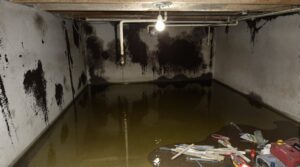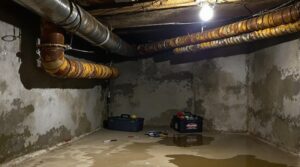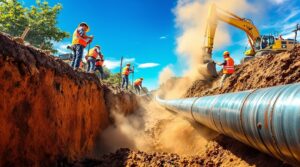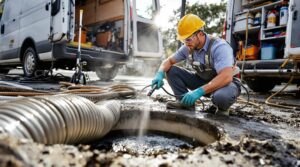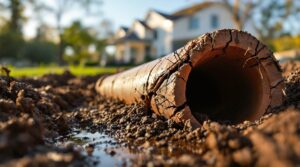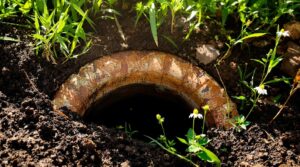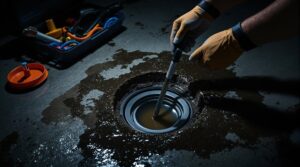Sewage leaks require immediate action to protect health and property. Property owners must first shut off the water source and evacuate people from contaminated areas. Essential steps include documenting damage, using protective gear, and containing the spread with absorbent materials. Professional plumbers should inspect the issue using techniques like camera inspections to determine repair needs. Understanding proper procedures and insurance implications can greatly impact the resolution of sewage-related incidents.
Key Takeaways
- Immediately shut off the main water supply and evacuate people and pets from the contaminated area.
- Block off the affected area and wear protective gear like waterproof gloves and boots when inspecting the leak.
- Look for warning signs like unusually lush grass patches, soggy areas, or foul odors to identify leak locations.
- Document the damage with photos and contact your insurance company to initiate a claim process.
- Call a licensed plumber for professional inspection and repairs, as sewage leaks require specialized expertise.
Common Warning Signs of a Sewage Leak
When homeowners suspect a sewage leak in their yard, several distinctive warning signs can help confirm their concerns.
Visual indicators include unusually lush grass patches growing at accelerated rates, as sewage acts as an unintended fertilizer. Soggy areas or puddles, particularly during dry weather, often signal underground pipe failures. For effective sewage leak prevention, homeowners should regularly inspect their yards for these telltale signs. If you discover any wet spots, be sure to turn off water immediately to prevent further damage.
Additional warning signals manifest through structural and systemic issues. Slow-draining fixtures, unexplained increases in water bills, and foundation cracks may indicate serious sewer line problems requiring emergency response.
Foul odors resembling rotten eggs, accompanied by increased pest activity, strongly suggest sewage contamination. The presence of damp floors, basement odors, and wall cracks can also point to underground leakage.
These issues demand immediate attention, as sewage leaks pose significant environmental hazards and can lead to costly property damage if left unaddressed.
Quick Actions to Take When You Spot a Leak
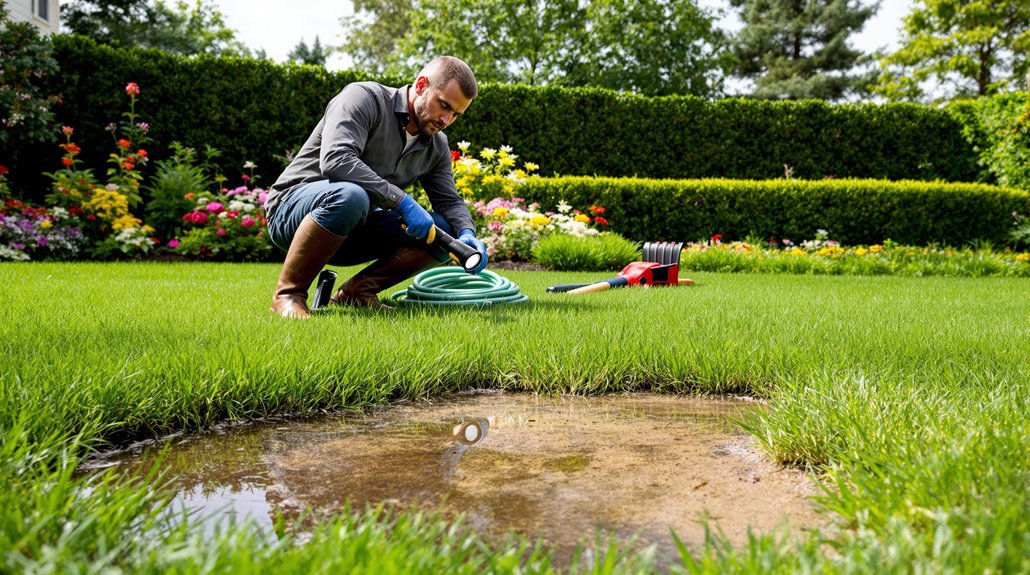
Upon discovering signs of a sewage leak, immediate and decisive action can prevent extensive property damage and health risks.
Effective leak detection begins with shutting off the water source and evacuating people and pets from the contaminated area. If safe, power should be disconnected to rooms with standing water, and toilet usage should cease until repairs are complete.
Professional repair techniques require specialized knowledge, making it essential to contact a qualified plumber or sewage specialist immediately. Call Mr. Rooter Plumbing for 24/7 emergency assistance.
While awaiting professional assistance, implementing basic safety measures is vital:
- Wear appropriate protective gear including rubber gloves and face masks
- Maintain proper ventilation by opening windows and using fans
- Avoid skin contact with contaminated water
- Keep children and pets away from affected areas
- Turn off nearby fuel systems to prevent additional hazards
The initial response should focus on containment rather than thorough cleanup.
Using absorbent materials to control the spill's spread and implementing proper ventilation can minimize damage until professional intervention begins.
Professional Solutions and Repair Options
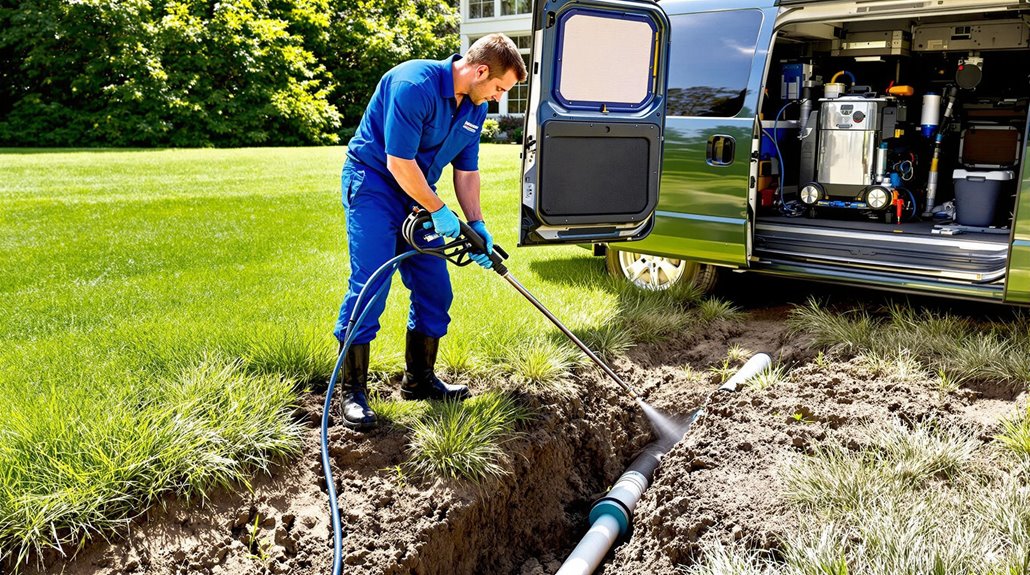
Modern sewage repair technologies offer both trenchless and traditional solutions for addressing yard leaks effectively. Professional repair methods range from innovative trenchless technologies to conventional excavation approaches, each suited for specific damage scenarios.
| Method | Application | Duration |
|---|---|---|
| CIPP Lining | Minor to moderate damage | 12-24 hours |
| Pipe Bursting | Severe pipe damage | 1-2 days |
| Robotic Repair | Targeted fixes | Hours |
Trenchless technologies like Cured-In-Place Pipe lining and pipe bursting minimize surface disruption while providing long-lasting solutions. CIPP creates a new pipe within the existing one, while pipe bursting completely replaces damaged sections. For less severe cases, robotic repairs offer precise, targeted solutions through remote-controlled equipment. Traditional excavation methods remain necessary for situations where trenchless approaches aren't feasible, particularly in cases of extensive damage or when access points are limited. Professional contractors evaluate factors such as pipe condition, accessibility, and damage extent to determine the most appropriate repair method. Slip lining repairs can often be completed within a few days, offering an efficient solution while maintaining continuous sewer service.
Health Risks and Safety Precautions
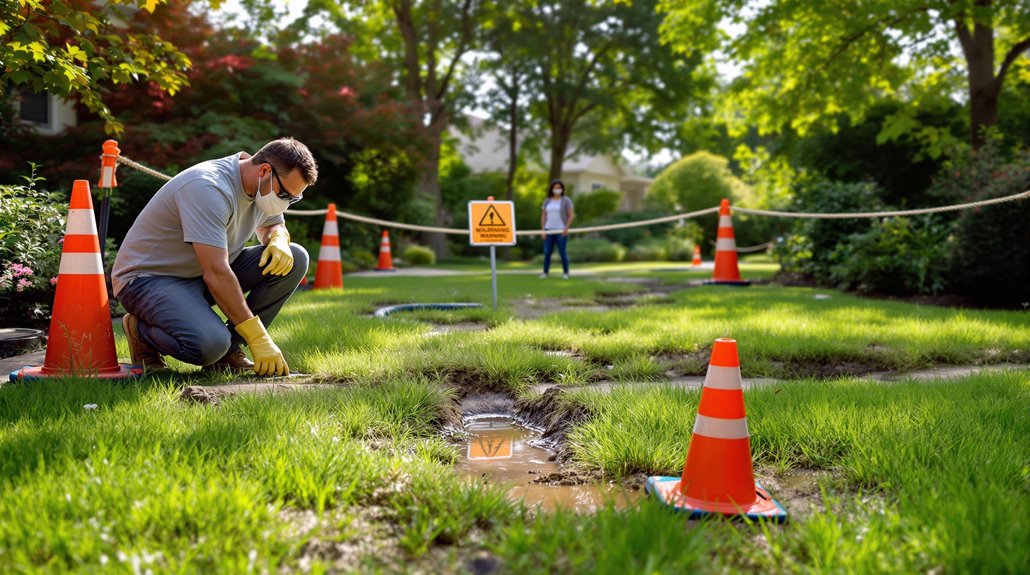
Sewage leaks present serious health hazards that require immediate attention and proper safety protocols to minimize exposure risks.
Essential protective equipment includes waterproof gloves, boots, and protective clothing when working near contaminated areas.
Maintaining strict hygiene practices, such as thorough handwashing and separating contaminated clothing, helps prevent the transmission of harmful pathogens like E. coli, Salmonella, and hepatitis A.
Minimize Exposure Risks
A thorough understanding of exposure risks is vital when dealing with sewage leaks in residential yards. Immediate action must be taken to minimize sewage exposure and prevent contamination risks to both inhabitants and the environment.
The primary focus should be on isolating the affected area and implementing protective measures.
Key steps to minimize exposure include:
- Shutting off the main water supply immediately
- Evacuating all residents from the contaminated zone
- Establishing barriers around the affected area
- Documenting the extent of contamination
- Contacting professional remediation services
Professional assessment and intervention are imperative, as improper handling can exacerbate health risks.
The containment of sewage must be prioritized to prevent spread to unaffected areas, while proper documentation supports insurance claims and guarantees thorough remediation efforts.
Proper Safety Equipment
Protecting against sewage contamination requires detailed safety equipment and strict adherence to protective protocols. Workers must utilize full-body impervious suits, rubber boots, and chemical-resistant gloves to prevent skin contact with hazardous materials.
Safety training emphasizes the mandatory use of hard hats and eye protection against physical and chemical risks. For operations involving large sewage tanks, full-face supplied-air respirators with escape packs are essential. Proper equipment maintenance of ventilation systems guarantees safe atmospheric conditions during cleanup procedures.
Additional protective measures include securing all drainage systems, posting warning signs, and isolating work areas with disposable plastic sheeting. These thorough safety protocols help prevent exposure to dangerous pathogens like E. coli, Campylobacter, and Cryptosporidium, which can cause severe illness.
Preventing Future Sewage Problems
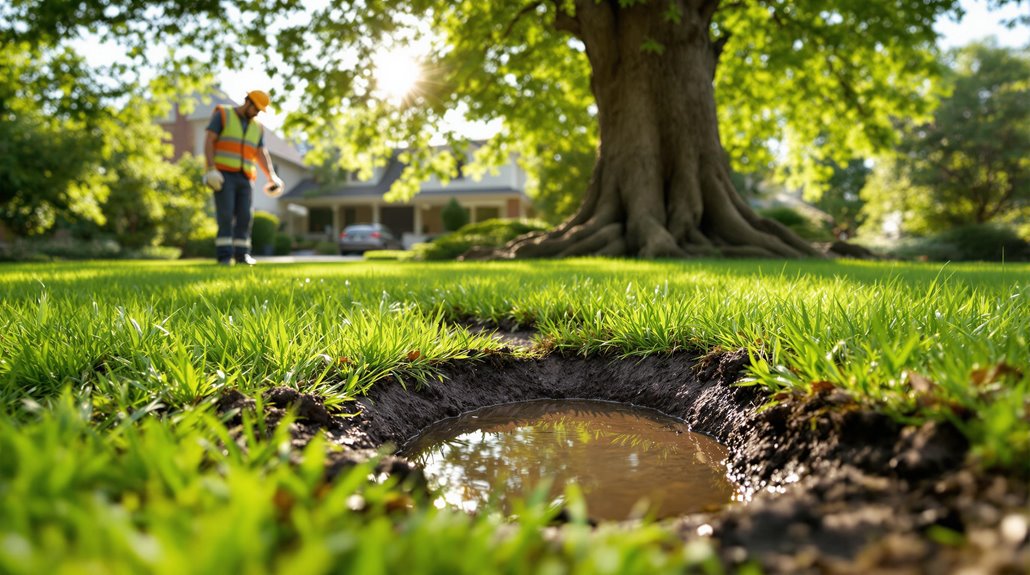
Regular inspections conducted by licensed plumbers help identify potential sewage issues before they escalate into major problems requiring costly repairs.
Root intrusion poses a significant threat to sewer line integrity, necessitating proper tree placement and periodic monitoring of vegetation near underground pipes.
Property owners should establish a maintenance schedule that includes camera inspections of sewer lines and root barrier installation where necessary.
Regular Inspection Schedule
Proper inspection schedules form the cornerstone of effective sewage system maintenance, with experts recommending thorough evaluations every 1-3 years throughout property ownership. These inspections guarantee septic system longevity and prevent costly repairs while protecting household health. Regular evaluations not only identify potential issues before they escalate but also provide valuable insights into the overall efficiency of the system. Moreover, incorporating cleaning sewage pipe techniques during these inspections can significantly enhance the system’s performance and reduce the risk of clogs and backups. By prioritizing maintenance and utilizing advanced cleaning methods, property owners can ensure a safe and reliable sewage system for years to come.
Complete evaluations include tank examination, drain field analysis, and structural integrity verification.
Key inspection components include:
- Measuring sludge and scum levels in septic tanks
- Evaluating baffle and tee functionality
- Checking for signs of leakage or corrosion
- Inspecting distribution box flow patterns
- Analyzing drain field condition using dye tests
Professional inspectors utilize specialized tools like cameras to examine pipes and leach lines, documenting system conditions and recommending necessary maintenance.
This systematic approach helps identify potential issues before they escalate into serious problems, securing excellent system performance and regulatory compliance.
Root Growth Management
Tree roots relentlessly seek moisture and nutrients, making underground sewer systems particularly vulnerable to root intrusion. The warm, moist environment within sewer pipes creates ideal conditions for root penetration, especially through cracks and loose joints.
Even during winter dormancy, roots continue their infiltration.
Effective management requires a multi-faceted approach. Installing root barriers between trees and pipes provides mechanical protection, while strategic tree selection utilizing "sewer-safe" species like cypress or flowering dogwood minimizes risk.
Maintaining a minimum distance of 10 feet between new plantings and sewer lines creates an essential buffer zone. Regular applications of EPA-registered root-killing products, combined with hydro-jetting maintenance, help prevent regrowth and clear existing blockages.
Professional intervention guarantees proper product application and system maintenance for maximal root control.
Understanding Your Responsibilities as a Property Owner

When property owners take on the role of landlord, they assume significant legal and practical obligations regarding sewage system maintenance and repair. Effective property maintenance requires systematic inspections, regular upkeep of plumbing systems, and prompt response to reported issues.
Landlords must maintain clear tenant communication channels and document all maintenance activities and complaints. Property owners bear legal responsibility for sewer-related problems unless tenant negligence can be proven.
To minimize liability and protect their investment, landlords should implement these essential practices:
- Conduct scheduled inspections of plumbing and drainage systems
- Maintain detailed records of all repairs and maintenance activities
- Provide tenants with emergency protocols and contact information
- Schedule preventive maintenance, including video pipe inspections
- Respond promptly to reported leaks or drainage issues
Understanding these responsibilities helps property owners protect their assets while ensuring tenant safety and satisfaction.
Failure to meet these obligations can result in property damage, legal complications, and financial losses.
The Benefits Of Consulting A Public Adjuster

Public adjusters provide expert insurance claim advocacy and objective damage assessment when dealing with sewage leaks on residential properties.
Their professional experience enables a streamlined claims process through thorough documentation, accurate damage evaluation, and skilled negotiation with insurance carriers.
Studies have shown that claims handled by licensed public adjusters often result in higher settlements compared to those filed directly by property owners, making their contingency-based fees a worthwhile investment for complex sewage damage cases.
Early involvement of licensed public adjusters in sewage leak claims helps ensure comprehensive documentation of all damages and prevents potential complications that could limit settlement options.
Expertise In Insurance Claims
Dealing with sewage leaks can involve complex insurance claims that require professional expertise to navigate effectively. Public adjusters offer specialized knowledge in claim negotiation and insurance policy interpretation, ensuring homeowners receive fair compensation for sewage-related damages.
These licensed professionals work exclusively for policyholders, providing objective assessments and thorough documentation of property damage.
Key services provided by public adjusters include:
- Detailed evaluation of sewage damage extent and associated costs
- Extensive review of insurance policy coverage and exclusions
- Professional documentation and submission of claims
- Strategic negotiation with insurance carriers
- Management of complex paperwork and administrative requirements
Their expertise particularly benefits homeowners dealing with extensive sewage damage, as these claims often involve multiple coverage aspects, including property damage, contamination remediation, and potential structural issues.
Working with public adjusters' expertise often leads to higher settlement amounts compared to accepting initial offers from insurance company adjusters.
Objective Damage Assessment
Professional evaluation of sewage damage requires an objective assessment conducted by qualified public adjusters who can accurately determine the full scope and financial impact of the incident.
Their expertise guarantees thorough documentation of affected areas, including damaged landscaping and soil contamination, which is vital for insurance claims processing.
Public adjusters systematically evaluate the extent of contamination, document all damages through detailed photographs, and maintain records of associated costs. This methodical approach helps property owners avoid common pitfalls in the claims process while guaranteeing fair compensation.
Their assessment includes identifying immediate safety hazards, evaluating structural impacts, and determining necessary cleanup protocols.
Through their specialized knowledge, adjusters can advocate for appropriate restoration measures that address both visible damage and potential long-term effects of sewage exposure.
Streamlined Claim Process
When facing sewage damage claims, consulting a public adjuster transforms a potentially overwhelming process into a streamlined operation.
These licensed professionals employ proven claims documentation strategies while managing all aspects of the insurance claim. Their expertise in insurance negotiation tactics guarantees extensive coverage and maximum settlement value for sewage-related property damage.
Public adjusters coordinate essential components of the claims process, including:
- Professional damage assessment and documentation
- Detailed inventory of affected areas and property
- Strategic compilation of supporting evidence
- Expert policy interpretation and compliance verification
- Skilled negotiation with insurance carriers
The adjuster's involvement allows property owners to focus on restoration while making sure the claim progresses efficiently.
Their specialized knowledge helps identify often-overlooked damage elements, particularly vital in sewage-related claims where contamination can extend beyond visible areas.
Higher Claim Payouts & Settlements
Engaging a public adjuster greatly improves claim settlement outcomes for sewage-related property damage. Through extensive damage evaluation and detailed documentation, adjusters identify all compensable losses, including those often overlooked during standard assessments.
Their expertise in policy interpretation guarantees full coverage utilization within established limits.
Public adjusters' proficiency in claim negotiations greatly impacts insurance payouts. They counter common insurance company tactics while advocating for maximum compensation based on documented evidence and professional damage reports.
Their thorough understanding of policy terms, coupled with strategic negotiation approaches, usually results in higher settlements compared to policyholder-managed claims.
This expertise proves particularly valuable in complex sewage damage scenarios, where proper damage assessment and documentation are vital for securing appropriate compensation.
Operating on contingency fee basis, public adjusters typically charge 5-20% of the final settlement amount, making their services accessible to most property owners.
About The Public Claims Adjusters Network (PCAN)

The Public Claims Adjusters Network (PCAN) represents a nationwide coalition of licensed, independent claims professionals who advocate exclusively for policyholders during insurance settlements.
PCAN members follow strict industry standards and maintain current knowledge of public claims trends to guarantee ideal outcomes for their clients. These certified professionals operate under rigorous regulatory requirements while providing thorough claims management services.
Their expertise spans residential and commercial property damage, with specialized focus on complex cases like sewage-related incidents.
- Review and interpret insurance policies to identify all applicable coverage
- Document and assess property damage through detailed inspections
- Calculate accurate claim values based on current market costs
- Negotiate directly with insurance carriers on behalf of policyholders
- Submit compliant documentation within required timeframes
PCAN members work on a contingency fee basis, collecting payment only after successful claim resolution. This arrangement aligns their interests with policyholders while guaranteeing access to professional claims advocacy services regardless of initial financial circumstances.
With annual earnings potential ranging from $60,000 to over $200,000, PCAN members are highly motivated to secure maximum settlements for their clients.
Frequently Asked Questions
How Much Does a Typical Sewage Leak Repair Cost?
With 80% of sewage leaks requiring professional intervention, typical repair costs range from $2,000-$5,000, varying based on sewage leak inspection findings and repair cost factors like pipe accessibility.
Can I Plant New Trees Near Repaired Sewer Lines?
Planting near repaired sewer lines requires strict tree root considerations. New trees should maintain minimum 10-foot planting distance regulations, with preference given to slow-growing species having non-aggressive root systems.
Does Homeowners Insurance Cover Sewage Leaks in the Yard?
Standard homeowners coverage typically excludes yard sewage leaks unless caused by specific covered perils. Additional sewage backup endorsements may provide protection, though coverage limits and deductibles apply separately.
How Long Do Modern Sewer Pipes Typically Last Before Needing Replacement?
Modern sewer pipe lifespan varies by material: PVC and cast iron pipes last 75-100 years, while concrete lasts 50-75 years. Aging infrastructure requires monitoring to determine ideal replacement timing.
What Landscape Features Can Help Identify Underground Sewer Line Locations?
Like ancient map markers, landscape features including cleanout pipes, utility flags, manholes, and surface depressions serve as reliable detection techniques for identifying underground sewer line locations and pathways.
References
- https://h2oc.org/resources/pollution-prevention-for-residents/sewage-maintenance/
- https://www.rapidplumbingsd.com/sewage-coming-out-of-pipe-in-yard/
- https://fixedtoday.com.au/blog/sewage-in-the-yard
- https://www.poolesplumbing.com/blog/sewage-leak/
- https://1stopmechanical.com/4-main-causes-of-sewer-leaks/
- https://www.paloaltoplumbing.net/tackling-a-sewer-leak-in-your-yard/
- https://www.expresssewer.com/blog/6-signs-your-home-may-have-a-leaking-sewer-pipe
- https://cactusplumbingandair.com/sewer-leak/
- https://www.oliverheatcool.com/about/blog/news-for-homeowners/plumbing-blog/5-signs-of-a-sewage-leak/
- https://www.mrrooter.com/greater-syracuse/about-us/blog/2015/may/keep-your-family-and-home-safe-during-sewage-lea/
